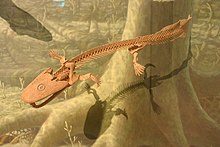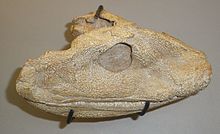
A tetrapod is any four-limbed vertebrate animal of the superclass Tetrapoda. Tetrapods include all extant and extinct amphibians and amniotes, with the latter in turn evolving into two major clades, the sauropsids and synapsids. Hox gene mutations have resulted in some tetrapods becoming limbless or two-limbed. Nevertheless, these limbless groups still qualify as tetrapods through their ancestry, and some retain a pair of vestigial spurs that are remnants of the hindlimbs.

Sarcopterygii — sometimes considered synonymous with Crossopterygii — is a clade of vertebrate animals which includes a group of bony fish commonly referred to as lobe-finned fish. These vertebrates are characterised by prominent muscular limb buds (lobes) within their fins, which are supported by articulated appendicular skeletons. This is in contrast to the other clade of bony fish, the Actinopterygii, which have only skin-covered bony spines supporting the fins.

Ichthyostega is an extinct genus of limbed tetrapodomorphs from the Late Devonian of what is now Greenland. It was among the earliest four-limbed vertebrates ever in the fossil record and was one of the first with weight-bearing adaptations for terrestrial locomotion. Ichthyostega possessed lungs and limbs that helped it navigate through shallow water in swamps. Although Ichthyostega is often labelled a 'tetrapod' because of its limbs and fingers, it evolved long before true crown group tetrapods and could more accurately be referred to as a stegocephalian or stem tetrapod. Likewise, while undoubtedly of amphibian build and habit, it is not a true member of the group in the narrow sense, as the first modern amphibians appeared in the Triassic Period. Until finds of other early stegocephalians and closely related fishes in the late 20th century, Ichthyostega stood alone as a transitional fossil between fish and tetrapods, combining fish and tetrapod features. Newer research has shown that it had an unusual anatomy, functioning more akin to a seal than a salamander, as previously assumed.
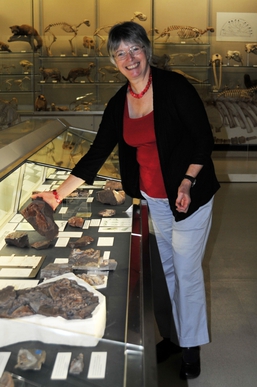
Jennifer Alice Clack, was an English palaeontologist and evolutionary biologist. She specialised in the early evolution of tetrapods, specifically studying the "fish to tetrapod" transition: the origin, evolutionary development and radiation of early tetrapods and their relatives among the lobe-finned fishes. She is best known for her book Gaining Ground: the Origin and Early Evolution of Tetrapods, published in 2002 and written with the layperson in mind.

Panderichthys is a genus of extinct sarcopterygian from the late Devonian period, about 380 Mya. Panderichthys, which was recovered from Frasnian deposits in Latvia, is represented by two species. P. stolbovi is known only from some snout fragments and an incomplete lower jaw. P. rhombolepis is known from several more complete specimens. Although it probably belongs to a sister group of the earliest tetrapods, Panderichthys exhibits a range of features transitional between tristichopterid lobe-fin fishes and early tetrapods. It is named after the German-Baltic paleontologist Christian Heinrich Pander. Possible tetrapod tracks dating back to before the appearance of Panderichthys in the fossil record were reported in 2010, which suggests that Panderichthys is not a direct ancestor of tetrapods, but nonetheless shows the traits that evolved during the fish-tetrapod evolution

Hynerpeton is an extinct genus of early four-limbed vertebrate that lived in the rivers and ponds of Pennsylvania during the Late Devonian period, around 365 to 363 million years ago. The only known species of Hynerpeton is H. bassetti, named after the describer's grandfather, city planner Edward Bassett. Hynerpeton is known for being the first Devonian four-limbed vertebrate discovered in the United States, as well as possibly being one of the first to have lost internal (fish-like) gills.

Tiktaalik is a monospecific genus of extinct sarcopterygian from the Late Devonian Period, about 375 Mya, having many features akin to those of tetrapods. Tiktaalik is estimated to have had a total length of 1.25–2.75 metres (4.1–9.0 ft) on the basis of various specimens.

Crassigyrinus is an extinct genus of carnivorous stem tetrapod from the Early Carboniferous Limestone Coal Group of Scotland and possibly Greer, West Virginia.

Ventastega is an extinct genus of stem tetrapod that lived during the Upper Fammenian of the Late Devonian, approximately 372.2 to 358.9 million years ago. Only one species is known that belongs in the genus, Ventastega curonica, which was described in 1996 after fossils were discovered in 1933 and mistakenly associated with a fish called Polyplocodus wenjukovi. ‘Curonica’ in the species name refers to Curonia, the Latin name for Kurzeme, a region in western Latvia. Ventastega curonica was discovered in two localities in Latvia, and was the first stem tetrapod described in Latvia along with being only the 4th Devonian tetrapodomorph known at the time of description. Based on the morphology of both cranial and post-cranial elements discovered, Ventastega is more primitive than other Devonian tetrapodomorphs including Acanthostega and Ichthyostega, and helps further understanding of the fish-tetrapod transition.

Tulerpeton is an extinct genus of Devonian four-limbed vertebrate, known from a fossil that was found in the Tula Region of Russia at a site named Andreyevka. This genus and the closely related Acanthostega and Ichthyostega represent the earliest tetrapods.
A limb is a jointed, muscled appendage of a tetrapod vertebrate animal used for weight-bearing, terrestrial locomotion and physical interaction with other objects. The distalmost portion of a limb is known as its extremity. The limbs' bony endoskeleton, known as the appendicular skeleton, is homologous among all tetrapods, who use their limbs for walking, running and jumping, swimming, climbing, grasping, touching and striking.
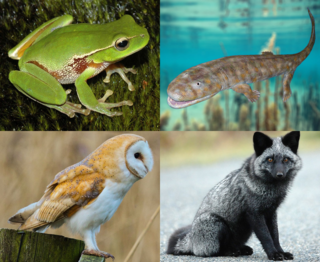
Stegocephali is a clade of vertebrate animals containing all fully limbed tetrapodomorphs. It is equivalent to a broad definition of the superclass Tetrapoda: under this broad definition, the term "tetrapod" applies to any animal descended from the first vertebrate with four limbs each with digits in the extremity (pentadactyly), rather than fins of their sarcopterygian relatives.

Elpistostegalia is a clade containing Panderichthys and all more derived tetrapodomorph taxa. The earliest elpistostegalians, combining fishlike and tetrapod-like characters, such as Tiktaalik, are sometimes called fishapods. Although historically Elpistostegalia was considered an order of prehistoric lobe-finned fishes, it was cladistically redefined to include tetrapods.
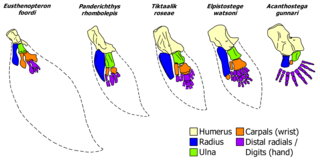
Polydactyly in stem-tetrapods should here be understood as having more than five digits to the finger or foot, a condition that was the natural state of affairs in the earliest stegocephalians during the evolution of terrestriality. The polydactyly in these largely aquatic animals is not to be confused with polydactyly in the medical sense, i.e. it was not an anomaly in the sense it was not a congenital condition of having more than the typical number of digits for a given taxon. Rather, it appears to be a result of the early evolution from a limb with a fin rather than digits.

Ichthyostegalia is an order of extinct amphibians, representing the earliest landliving vertebrates. The group is thus an evolutionary grade rather than a clade. While the group are recognized as having feet rather than fins, most, if not all, had internal gills in adulthood and lived primarily as shallow water fish and spent minimal time on land.
Antlerpeton is an extinct genus of early tetrapod from the Early Carboniferous of Nevada. It is known from a single poorly preserved skeleton from the Diamond Peak Formation of Eureka County. A mix of features in its compound vertebrae suggest that Antlerpeton is a primitive stem tetrapod that has affinities with later, more advanced forms. Its robust pelvis and hind limbs allowed for effective locomotion on land, but the animal was likely still tied to a semiaquatic lifestyle near the coast.

Tinirau is an extinct genus of sarcopterygian fish from the Middle Devonian of Nevada. Although it spent its entire life in the ocean, Tinirau is a stem tetrapod close to the ancestry of land-living vertebrates in the crown group Tetrapoda. Relative to more well-known stem tetrapods, Tinirau is more closely related to Tetrapoda than is Eusthenopteron, but farther from Tetrapoda than is Panderichthys. The type and only species of Tinirau is T. clackae, named in 2012.

The evolution of tetrapods began about 400 million years ago in the Devonian Period with the earliest tetrapods evolved from lobe-finned fishes. Tetrapods are categorized as animals in the biological superclass Tetrapoda, which includes all living and extinct amphibians, reptiles, birds, and mammals. While most species today are terrestrial, little evidence supports the idea that any of the earliest tetrapods could move about on land, as their limbs could not have held their midsections off the ground and the known trackways do not indicate they dragged their bellies around. Presumably, the tracks were made by animals walking along the bottoms of shallow bodies of water. The specific aquatic ancestors of the tetrapods, and the process by which land colonization occurred, remain unclear. They are areas of active research and debate among palaeontologists at present.
Innovations conventionally associated with terrestrially first appeared in aquatic elpistostegalians such as Panderichthys rhombolepis, Elpistostege watsoni, and Tiktaalik roseae. Phylogenetic analyses distribute the features that developed along the tetrapod stem and display a stepwise process of character acquisition, rather than abrupt. The complete transition occurred over a period of 30 million years beginning with the tetrapodomorph diversification in the Middle Devonian.
The vertebrate land invasion refers to the transition of vertebrate animals from being aquatic/semiaquatic to predominantly terrestrial during the Late Devonian period. This transition allowed some vertebrates to escape competitive pressure from other aquatic animals and explore niches on land, which eventually established the vertebrates as the dominant terrestrial phylum. Fossils from this period have allowed scientists to identify some of the species that existed during this transition, such as Tiktaalik and Acanthostega. Many of these species were also the first to develop adaptations suited to terrestrial over aquatic life, such as neck mobility, more robust lungs and hindlimb locomotion.
